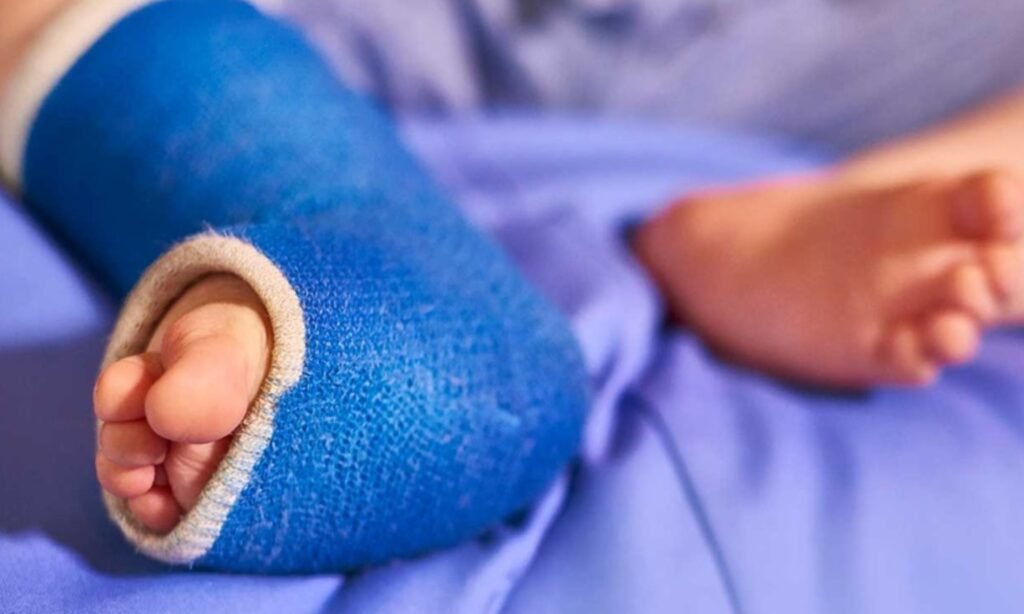Clubbed Foot

Clubbed foot, also known as congenital talipes equinovarus (CTEV), is one of the most common congenital deformities affecting the lower limbs. This condition, present at birth, causes the foot to twist inward and downward, leading to significant challenges in mobility and overall quality of life if left untreated. This extensive guide aims to provide an in-depth understanding of clubbed foot, covering its causes, diagnosis, treatment options, and long-term management.
What Is Clubbed Foot?
Clubbed foot refers to a structural deformity where the affected foot is turned inward and downward. This condition can occur in one foot (unilateral) or both feet (bilateral). The severity of the condition varies, with some cases being mild and others requiring extensive treatment.
The primary components of the deformity include:
- Cavus:- An increased arch of the foot.
- Adductus:- Inward turning of the forefoot.
- Varus:- Inward angulation of the heel.
- Equinus:- Downward pointing of the foot, often with limited dorsiflexion.
Epidemiology
- Prevalence:- Clubbed foot affects approximately 1 in 1,000 live births globally. The condition is more common in males than females, with a male-to-female ratio of about 2:1.
- Geographical Variation:- The prevalence varies across regions, with higher rates observed in some African and Asian populations compared to Western countries.

Types of Clubbed Foot
Clubbed foot is categorized into:
- Idiopathic : The most common type, with no identifiable underlying cause.
- Syndromic : Associated with other congenital anomalies or syndromes, such as Down syndrome or Larsen syndrome.
- Neurogenic : Related to neuromuscular conditions like spina bifida.
- Postural/Positional : Caused by external factors, such as uterine constraint, and often resolves with minimal intervention.
Causes and Risk Factors
The exact cause of clubbed foot is not fully understood, but it is believed to result from a combination of genetic and environmental factors.
- Genetic Factors:
- A positive family history increases the risk significantly.
- Specific genes associated with musculoskeletal development, such as PITX1 and TBX4, may play a role.
- Environmental Factors :
- Intrauterine Positioning : Limited space in the womb can contribute to abnormal foot positioning.
- Maternal Lifestyle Factors : Smoking, drug use, and poor nutrition during pregnancy can increase the risk.
- Oligohydramnios: Reduced amniotic fluid levels may restrict fetal movement.
- Associated Conditions :
- Spina bifida and other neuromuscular disorders.
- Arthrogryposis, characterized by joint contractures.
Diagnosis
- Prenatal Diagnosis :
- Ultrasound : Advanced imaging can detect clubbed foot as early as the second trimester.
- Amniocentesis : May be used if a genetic syndrome is suspected.
- Postnatal Diagnosis :
- Physical Examination : The deformity is apparent at birth, with visual signs of inward and downward foot positioning.
- Imaging : X-rays and, occasionally, MRI may be used to assess the severity of the deformity.
Complications
Recurrence : One of the most common complications, especially if bracing protocols are not followed.
Stiffness and Pain : Can occur in surgically treated cases.
Residual Deformities : May require secondary interventions.
Psychological and Social Considerations
Children with untreated or poorly treated clubbed foot may face challenges such as:
- Social stigma and bullying.
- Limited participation in physical activities.
- Psychological impact due to visible deformity.
Treatment Options
Early treatment is crucial for achieving optimal outcomes. A multidisciplinary approach involving orthopedic specialists, physiotherapists, and, in some cases, surgeons is essential.
- Non-Surgical Management :
- Ponseti Method : This is the gold standard of treatment, involving serial casting to gradually correct the deformity, followed by Achilles tendon release if needed.
- French Physiotherapy Method : A technique involving daily manipulation, taping, and splinting, followed by long-term bracing.
- Surgical Treatment :
- Reserved for severe or resistant cases.
- Procedures include tendon transfer, osteotomy, and joint release.
- Postoperative bracing is essential to maintain correction.
- Bracing and Maintenance:
- Following correction, braces such as Dennis Browne bars are used to prevent recurrence.
- Bracing typically continues until the child is 4-5 years old.




Prognosis
With timely and appropriate treatment, most children with clubbed foot can achieve functional, pain-free feet. However, lifelong monitoring may be necessary, especially in severe cases or those requiring surgery.
Advances in Research
- Genetic Studies : Ongoing research into the genetic basis of clubbed foot may lead to improved diagnostic and treatment strategies.
- 3D Printing : Customized braces and orthotics using 3D printing technology are being explored.
- Minimally Invasive Techniques : Advancements in surgical methods aim to reduce recovery time and complications.
Support for Families
- Parents of children with clubbed foot should receive comprehensive education and support, including:
- Guidance on treatment protocols and the importance of adherence.
- Access to support groups and counseling services.
- Information on financial assistance for treatment costs.
Conclusion
Clubbed foot is a complex yet manageable condition. Early diagnosis and a proactive approach to treatment can significantly improve outcomes, enabling children to lead active and fulfilling lives. Continued advancements in medical research and technology promise even better solutions for those affected by this challenging condition.

